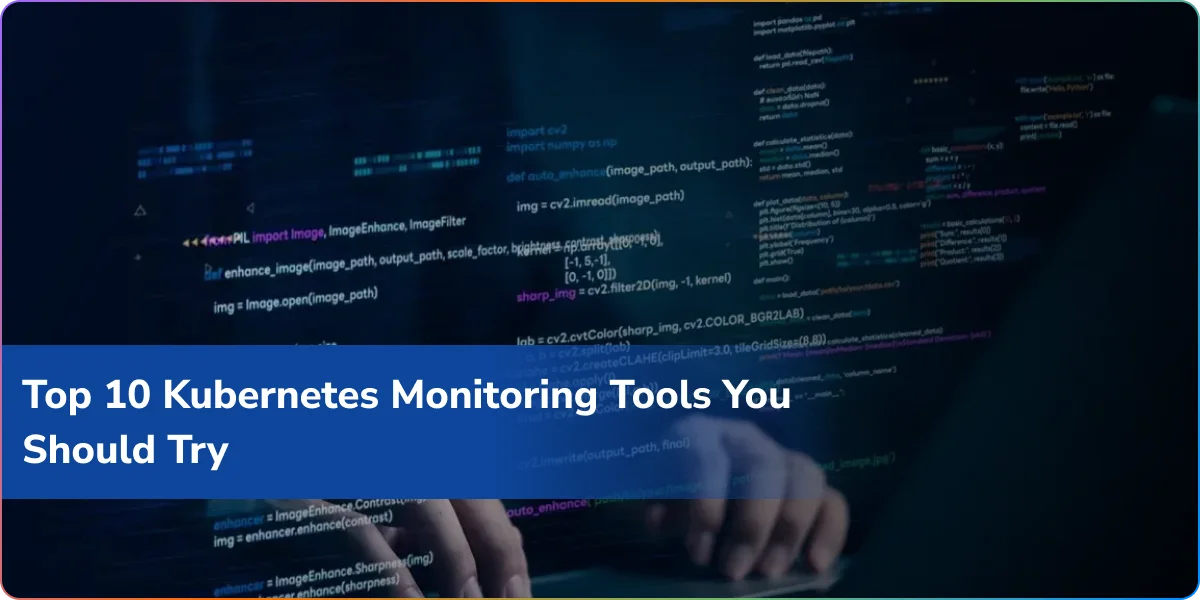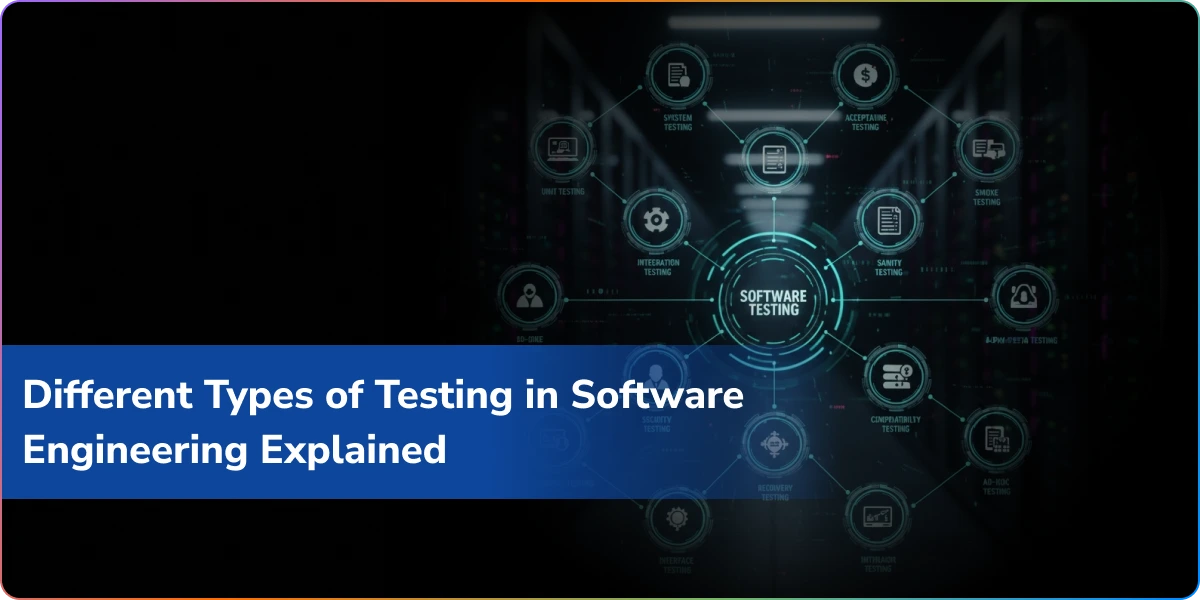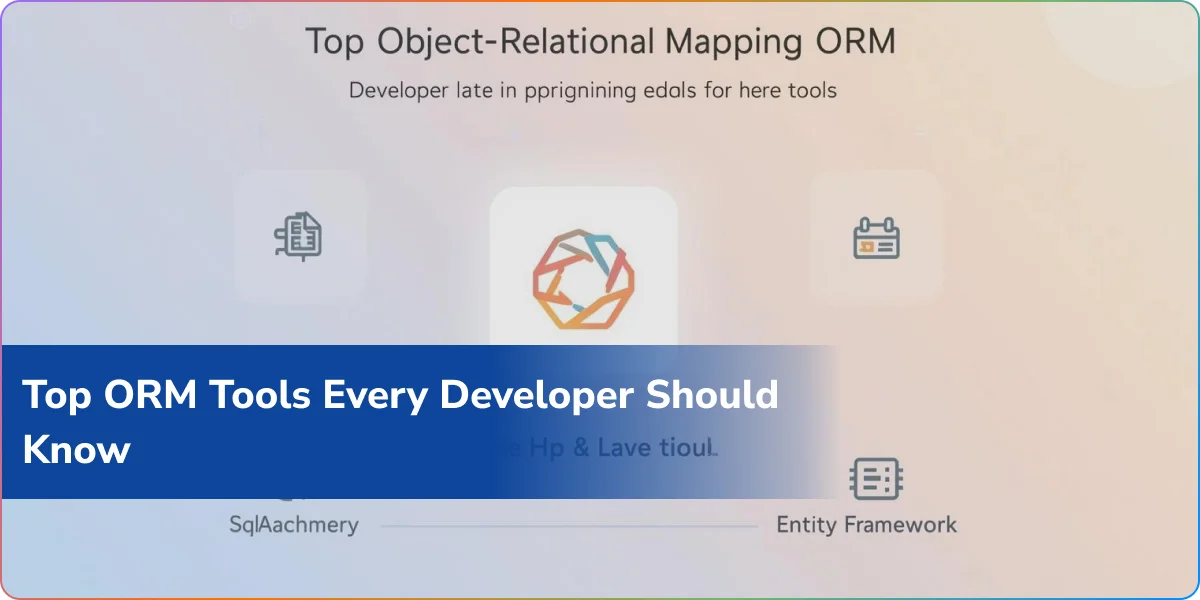Have you ever deployed your app on Kubernetes and wondered why monitoring feels harder than scaling? You’re not alone. While Kubernetes makes deployments simple, it creates challenges in tracking performance, uptime, and costs.
That’s where the right Kubernetes monitoring tools come in. They give you real-time insights into cluster health, logs, and resource usage—so you can avoid bottlenecks and downtime. In this blog, we’ll explore the best Kubernetes monitoring tools, their features, and how they improve observability, logging, and cost management.
Why Do You Need Kubernetes Monitoring?
- Kubernetes is powerful, but pods and containers scale quickly, and issues can appear anytime.
- Monitoring lets you catch problems early, keep your apps running smoothly, gain real-time insights, control cloud costs, and maintain security and compliance.
- Whether you manage small deployments or large clusters, the right monitoring tools ensure your Kubernetes environment stays stable, reliable, and stress-free.
Top 10 Kubernetes Monitoring Tools
Let’s explore the most popular and effective Kubernetes monitoring tools available today.
1. Prometheus
Struggling to track your Kubernetes performance? Prometheus makes monitoring simple, reliable, and scalable with its open-source power.
Key Features:
- Collects metrics using a multi-dimensional data model.
- Pulls metrics via HTTP for accurate monitoring.
- Integrates seamlessly with Kubernetes.
- Works with Grafana to create clear visual dashboards.
Use Cases:
- Monitor pod and container performance in real time.
- Track resource usage across large Kubernetes clusters.
- Set up alerts for anomalies or failures to prevent downtime.
- Visualize metrics for capacity planning and scaling decisions.
Prometheus serves as the backbone for many Kubernetes observability setups thanks to its powerful ecosystem and flexibility.
2. Grafana
Prometheus collects metrics, but Grafana transforms them into clear, visual insights. Together, they form one of the most powerful K8s monitoring tool combinations.
Key Features:
- Beautiful dashboards for cluster and pod monitoring
- Custom alerting options
- Supports multiple data sources beyond Kubernetes
Use Cases:
- Create real-time dashboards to track pod health and cluster performance
- Set custom alerts to notify teams when resources exceed thresholds
- Combine data from multiple sources (e.g., Prometheus, Loki, Elasticsearch) for unified monitoring
- Share intuitive visual reports with stakeholders for better decision-making
3. Datadog
Want to see your entire Kubernetes environment in one place? Datadog delivers cloud-native, full-stack monitoring.
Key Features:
- Full-stack observability with metrics, traces, and logs
- Advanced Kubernetes logging tools integration
- AI-driven anomaly detection alerts
- Kubernetes cost monitoring and visibility
Use Cases:
- Monitor Kubernetes clusters, pods, and workloads in real time
- Detect anomalies with AI-driven alerts before they impact performance
- Analyze logs to quickly debug issues inside containers
- Track and optimize Kubernetes infrastructure costs across environments
- Provide unified observability for DevOps, developers, and business teams in one dashboard
4. New Relic
Managing Kubernetes visibility doesn’t have to be complex. New Relic simplifies it with automatic discovery and full observability.
Key Features:
- Auto-discovers Kubernetes workloads
- Real-time dashboards for cluster, pod, and node health
- Log management with Kubernetes logging tools
- Supports distributed tracing across microservices
- Kubernetes cost management and optimization features
Use Cases:
- Gain real-time visibility into Kubernetes workloads without manual setup
- Monitor pod and node health to ensure application reliability
- Centralize and analyze Kubernetes logs for faster debugging
- Trace requests across microservices to identify performance bottlenecks
- Optimize Kubernetes infrastructure spend with a detailed cost analysis
5. Dynatrace
Dynatrace delivers AI-powered observability and root-cause analysis for Kubernetes workloads.
| Key Features | Use Cases | Benefits |
| OneAgent auto-detects Kubernetes clusters | Deploy quickly without manual setup | Saves engineering time and reduces setup errors |
| Full-stack Kubernetes observability tools | Track performance across pods, nodes, and clusters | Ensures reliability and complete visibility |
| AI-based intelligent alerts | Detect and fix issues before they affect users | Improves uptime and enhances user experience |
| Kubernetes cost monitoring | Optimize cloud spend and prevent cost overruns | Reduces unnecessary costs and improves budgeting |
Use Dynatrace if you want automation, AI-powered root-cause analysis, and proactive problem-solving with one of the best Kubernetes monitoring tools.
6. ELK Stack (Elasticsearch, Logstash, Kibana)
The ELK Stack is a popular solution for centralized logging and visualization in Kubernetes.
| Key Features | Use Cases | Benefits |
| Elasticsearch stores and searches logs | Efficient log management and quick retrieval | Faster troubleshooting with quick access to logs |
| Logstash collects and processes data | Aggregate logs from multiple Kubernetes sources | Unified data pipeline for consistent log analysis |
| Kibana provides dashboards and visualizations | Monitor workloads with real-time visual insights | Better decision-making with intuitive dashboards |
| Seamless Kubernetes integration | Simplify centralized logging and troubleshooting | Reduced complexity in managing distributed logs |
Use ELK Stack if you need reliable centralized logging, visualization, and troubleshooting as part of your Kubernetes management toolkit.
7. Loki
Loki, built by Grafana Labs, is a lightweight and affordable log aggregation tool designed for Kubernetes.
Key Features:
- Indexes logs by labels instead of full text (faster and cheaper).
- Works smoothly with Grafana dashboards.
- More cost-effective than traditional Kubernetes logging tools.
Use Cases:
- Cost-Sensitive Teams: Developers who want reliable log aggregation without high storage costs.
- Grafana Users: Teams already using Grafana for monitoring can easily integrate Loki for a unified view.
- Kubernetes Troubleshooting: Engineers can quickly filter logs by labels like pod, namespace, or cluster to debug issues.
If you want a budget-friendly logging tool that integrates seamlessly with Grafana, Loki is a smart choice for Kubernetes log management.
8. Kubecost
Cloud costs shouldn’t surprise you at the end of the month. Kubecost makes Kubernetes expenses predictable. It is a specialized Kubernetes cost monitoring tool that helps teams manage cloud expenses effectively.
Key Features:
- Shows real-time cost visibility at the namespace, deployment, and pod level.
- Integrates with major cloud providers like AWS, GCP, and Azure.
- Answers the question: “What’s the best Kubernetes cost management tool?
- Provides optimization recommendations to reduce costs.
Use Cases:
- A finance team uses Kubecost to track which department’s workloads drive the most spending.
- A DevOps team monitors pod-level usage to identify overprovisioned resources.
- Cloud engineers rely on its insights to forecast budgets and avoid billing surprises.
Organizations choose Kubecost when they want to balance performance with cost efficiency in their Kubernetes environments.
9. Sysdig
Are your Kubernetes workloads truly secure? Sysdig helps you find out. Sysdig is a container-native security and monitoring platform designed for Kubernetes.
Key Features:
- Delivers real-time visibility into Kubernetes clusters.
- Combines monitoring with advanced security features.
- Tracks system calls for deep troubleshooting.
- Supports cost tracking and compliance monitoring.
Use Cases:
- Security-first teams use Sysdig to detect threats and enforce compliance policies.
- DevOps teams rely on Sysdig for troubleshooting performance issues at the container level.
- Finance and ops teams use its cost monitoring to keep Kubernetes workloads efficient.
If you want both Kubernetes observability and security in one platform, Sysdig is one of the best Kubernetes monitoring tools.
10. Zabbix
Need flexibility and cost efficiency? Zabbix offers open-source observability for Kubernetes at scale. It is an open-source enterprise monitoring platform that provides strong support for Kubernetes environments.
Key Features:
- Automatically discovers Kubernetes components.
- Offers customizable dashboards and alerting systems.
- Integrates with cloud providers and Kubernetes management tools.
- Scales reliably to handle large and complex infrastructures.
Use Cases:
- Ideal for teams that want a free, open-source monitoring tool with enterprise-grade capabilities.
- Works well for organizations managing large, distributed Kubernetes clusters.
- Preferred by DevOps teams that value flexibility, community support, and integrations with existing infrastructure tools.
If you want a community-driven, scalable, and open-source solution, Zabbix is one of the best Kubernetes monitoring tools to consider.
Comparing the Best Kubernetes Monitoring Tools
| Tool | Best For | Strength |
| Prometheus | Metrics | Scalability & ecosystem support |
| Grafana | Visualization | Dashboards & insights |
| Datadog | Enterprises | Full observability + cost monitoring |
| New Relic | Logs + Traces | Auto-discovery & cost features |
| Dynatrace | AI-driven Ops | Root-cause automation |
| ELK Stack | Logging | Centralized log management |
| Loki | Lightweight logging | Cost efficiency |
| Kubecost | Costs | Best Kubernetes cost monitoring tool |
| Sysdig | Security + Monitoring | Deep troubleshooting |
| Zabbix | Open-source | Customization & scalability |
Choosing the Right Kubernetes Monitoring Tool
So, what’s the best Kubernetes cost management tool or monitoring solution for your team? It depends on your use case:
- Metrics and performance: Prometheus + Grafana
- Logs: ELK Stack or Loki
- Enterprise-grade observability: Datadog or Dynatrace
- Cost management: Kubecost
Often, the best strategy is to combine tools—for example, use Prometheus for metrics, Grafana for visualization, and Kubecost for cost tracking
Conclusion
Kubernetes simplifies deployment but adds complexity in monitoring. The right Kubernetes monitoring solution ensures performance, reliability, and cost control.
From open-source tools like Prometheus and Loki to enterprise platforms like Datadog and Dynatrace, each offers unique strengths. For cost management, Kubecost leads the way, but combining it with other observability tools delivers complete visibility.
Not sure which Kubernetes management tools fit your needs? Our team at Logix Built Solutions Limited can help you compare, integrate, and optimize the right stack — so your clusters stay fast, reliable, and cost-efficient.
FAQ’s
1: What is Kubernetes monitoring, and why is it important?
Ans: K8s monitoring tracks cluster performance, resource usage, and health. It helps detect issues early, ensures high availability, and optimizes workloads.
2: Which are the best Kubernetes monitoring tools in 2025?
Ans: Top tools include Prometheus, Grafana, Datadog, New Relic, Dynatrace, and ELK Stack. Each offers features for observability, logging, and cost monitoring.
3: What is the difference between Kubernetes monitoring and logging tools?
Ans: Monitoring tools track metrics like CPU, memory, and pod health, while logging tools focus on application logs and error tracing. Used together, they give complete observability.
4: What’s the best Kubernetes cost management tool?
Ans: Kubecost and CloudHealth are top choices, helping teams manage cloud expenses, optimize workloads, and reduce unnecessary costs.
5: How do Kubernetes observability tools help DevOps teams?
Ans: Kubernetes observability tools give visibility into metrics, logs, and traces, helping DevOps troubleshoot faster, improve reliability, and monitor performance effectively.



